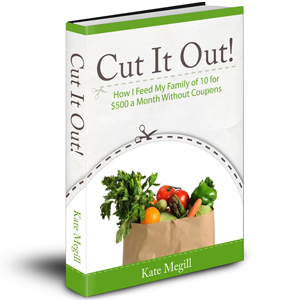 Blogger Kate Megill’s new e-book, Cut It Out! How I Feed My Family of 10 for $500 a Month, outlines how she and her college professor husband fed their family on a shoe-string, one-income budget for 27 years. In this post, Megill shares lessons she picked up from publishing the e-book that other freelancers and authors can learn from — MVR.
Blogger Kate Megill’s new e-book, Cut It Out! How I Feed My Family of 10 for $500 a Month, outlines how she and her college professor husband fed their family on a shoe-string, one-income budget for 27 years. In this post, Megill shares lessons she picked up from publishing the e-book that other freelancers and authors can learn from — MVR.
In the early years of our marriage, we lived on a $650 monthly grad school stipend while we grew our family. I had to learn quickly how to make those few dollars stretch while teaching my children to enjoy healthy food. The challenge had begun. I learned:
- How to menu plan – without it, I could not stay within my budget.
- How to build a price book that showed which stores had the best prices for each item, and how to detect sales patterns so I could stock up my pantries.
- The benefits of a well-stocked pantry.
- How to make household items such as laundry detergent and soft soap from scratch.
- Which foods not to skimp on, including which name brand items had a better taste and quality and which items didn’t matter.
It took me 27 years to learn and implement these lessons into my grocery shopping. I assumed everyone knew what I knew and did what I did. I found that is not the case. Because of various mentoring activities I’m involved with, I realized may women had no idea how to plan menus or find the best prices for various items. Their spending was significantly higher than mine with fewer children.
That gave me the idea to write the e-book.
Writing the e-book was a challenge. Correction: the writing part was easy. First I made an outline of the points to include. Then, over a weekend I wrote all the content for each outlined section — 33 pages in all.
In addition to the sections, I included an appendix with information from my blog about my master supper list and also some basic life skills very helpful in saving money.
The challenges of publishing and promoting an e-book
I’m not good at self-promotion – I’ve been a stay-at-home, home-schooling mom for 27 years! Fortunately I have friends who have encouraged, supported and promoted me all along the way. I also had the good fortune to read and follow Sarah Mae’s book How To Market And Sell Your E-book, an invaluable tool! I learned the importance of:
- Hiring an editor so your work is clear, concise and grammatically sound.
- Using a professional cover design, which can make or break your project.
- Having a website for your book with a recognizable domain name.
- Having your e-book professionally formatted for a .pdf, Kindle and Nook.
All of these cost money – my e-book cost about $300 – but it’s worth it because it takes a book into the professional sphere.
Networking to promote the e-book is still the hardest part for me. I contacted several small to medium bloggers I link up with every week and I posted on several Facebook blogging and writing groups I participate in. They all were willing to support and promote my e-book on their blogs, Facebook pages and Twitter. For me, Facebook has been the promotional biggest tool, because all my friends and family members shared my book information on their walls.
Kate Megill blogs at Teaching What Is Good and contributed to the e-book Apartment Gardening: A Practical Guide to Growing Vegetables in Small Places. Find her on Twitter at @teachwhatisgood, Facebook at /teachingwhatisgood and Pinterest at /mrsp31wannabe.

Using a professional cover design, which can make or break your project.
I agree with that a lot. Having a bland/blank cover with no meaning for colour can be quite a turn off to a book.